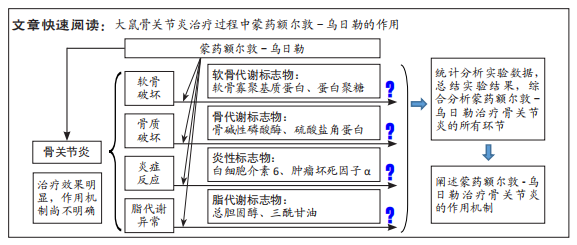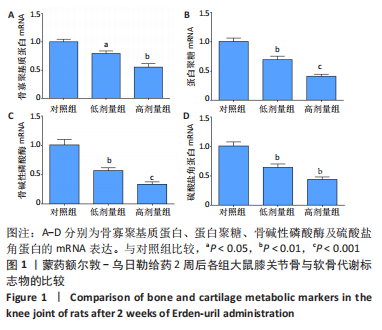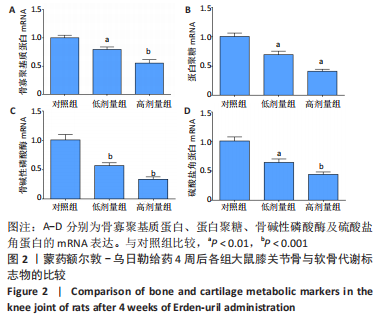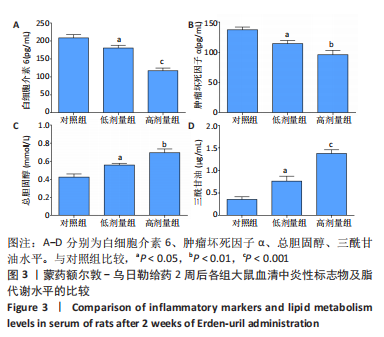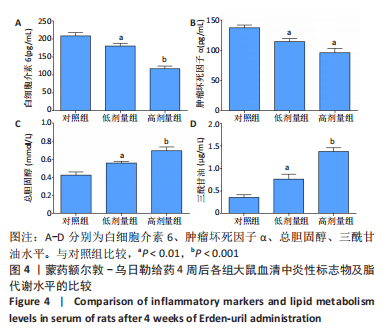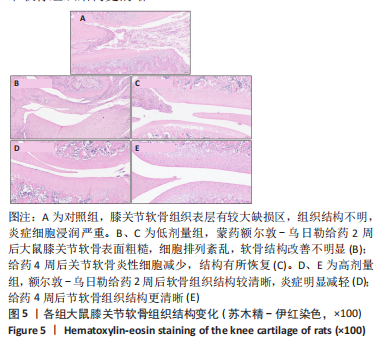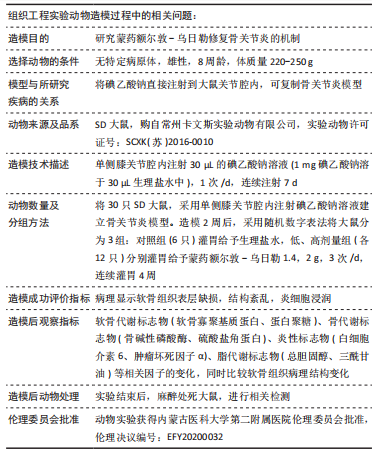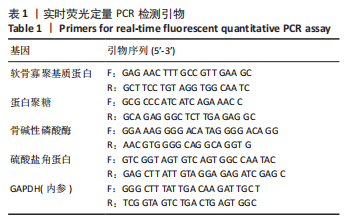[1] ABRAMOFF B, CALDERA FE. Osteoarthritis: Pathology, Diagnosis, and Treatment Options. Med Clin North Am. 2020;104(2):293-311.
[2] GILAT R, HAUNSCHILD ED, PATEL S, et al. Understanding the difference between symptoms of focal cartilage defects and osteoarthritis of the knee: a matched cohort analysis. Int Orthop. 2021;45(7):1761-1766.
[3] 王斌,邢丹,董圣杰,等.中国膝骨关节炎流行病学和疾病负担的系统评价[J]中国循证医学杂志,2018,18(2):134-142.
[4] XIE C, CHEN Q. Adipokines: New Therapeutic Target for Osteoarthritis? Curr Rheumatol Rep. 2019;21(12):71.
[5] WILKINSON DJ, HABGOOD A, LAMB HK, et al. Matriptase induction of metalloproteinase-dependent aggrecanolysis in vitro and in vivo: promotion of osteoarthritic cartilage damage by multiple mechanisms. Arthritis Rheumatol. 2017;69(8):1601-1611.
[6] YAMAMOTO K, WILKINSON D, BOU-GHARIOS G. Targeting Dysregulation of Metalloproteinase Activity in Osteoarthritis. Calcif Tissue Int. 2021; 109(3):277-290.
[7] BAILEY KN, NGUYEN J, YEE CS, et al. Mechanosensitive control of articular cartilage and subchondral bone homeostasis in mice requires osteocytic transforming growth factor beta signaling. Arthritis Rheumatol. 2021;73(3):414-425.
[8] 宇妥·元丹贡布.四部医典[M].呼和浩特市:内蒙古人民出版社, 1997:615-621.
[9] 中华人民共和国卫生部药典委员会中华人民共和国卫生部药品标准[S].蒙药分册,1998:160.
[10] 宝莉莉,宋福顺,都格尔,等.蒙药额尔敦-乌日勒的研究进展[J].中国民族民间医药,2019,28(3):53-56.
[11] ASGHAR S, LITHERLAND GJ, LOCKHART JC, et al. Exosomes in intercellular communication and implications for osteoarthritis. Rheumatology (Oxford). 2020;59(1):57-68.
[12] TAKAHASHI I, MATSUZAKI T, KUROKI H, et al. Joint unloading inhibits articular cartilage degeneration in knee joints of a monosodium iodoacetate-induced rat model of osteoarthritis. Osteoarthritis Cartilage. 2019;27(7):1084-1093.
[13] DRIBAN JB, HARKEY MS, BARBE MF, et al. Risk factors and the natural history of accelerated knee osteoarthritis: a narrative review. BMC Musculoskelet Disord. 2020;21(1):332.
[14] HULSHOF CTJ, COLOSIO C, DAAMS JG, et al. WHO/ILO work-related burden of disease and injury: Protocol for systematic reviews of exposure to occupational ergonomic risk factors and of the effect of exposure to occupational ergonomic risk factors on osteoarthritis of hip or knee and selected other musculoskeletal diseases. Environ Int. 2019;125:554-566.
[15] HALL M, VAN DER ESCH M, HINMAN RS, et al. How does hip osteoarthritis differ from knee osteoarthritis? Osteoarthritis Cartilage. 2022;30(1):32-41.
[16] 韩晗,张媛媛,潘立,等.中药有效成分防治骨性关节炎的研究进展[J].中国药科大学学报,2018,49(3):279-285.
[17] GAO MZ, CHEN C, ZHANG QY, et al. Research Progress on the Antiosteoarthritic Mechanism of Action of Natural Products. Evid Based Complement Alternat Med. 2021;2021:7714533.
[18] YAMAGUCHI R, YAMAMOTO T, MOTOMURA G, et al. Bone and cartilage metabolism markers in synovial fluid of the hip joint with secondary osteoarthritis. Rheumatology (Oxford). 2014;53(12):2191-2195.
[19] MIKAMI T, KITAGAWA H. Sulfated glycosaminoglycans: their distinct roles in stem cell biology. Glycoconj J. 2017;34(6):725-735.
[20] COPPELMAN EB, DAVID FH, TÓTH F, et al. The association between collagen and bone biomarkers and radiographic osteoarthritis in the distal tarsal joints of horses. Equine Vet J. 2020;52(3):391-398.
[21] PLSIKOVA MATEJOVA J, SPAKOVA T, HARVANOVA D, et al. A Preliminary Study of Combined Detection of COMP, TIMP-1, and MMP-3 in Synovial Fluid: Potential Indicators of Osteoarthritis Progression. Cartilage. 2021;13(2):1421S-1430S.
[22] MALY K, ANDRES SASTRE E, FARRELL E, et al. COMP and TSP-4: Functional Roles in Articular Cartilage and Relevance in Osteoarthritis. Int J Mol Sci. 2021;22(5):2242.
[23] SUN Y, TSUI YK, YU M, et al. Integration of a miniaturized DMMB assay with high-throughput screening for identifying regulators of proteoglycan metabolism. Sci Rep. 2022;12(1):1083.
[24] 潘建科,罗斌,郭达,等.龙鳖胶囊对膝骨关节炎大鼠IL-Iβ、IL-6、IL-10水平的影响[J].中华中医药杂志,2015,30(5):1675-1679.
[25] SIU WS, SHUM WT, CHENG W, et al. Topical application of Chinese herbal medicine DAEP relieves the osteoarthritic knee pain in rats. Chin Med. 2019;14:55.
[26] CAVALLO C, MERLI G, BORZÌ RM, et al. Small Extracellular Vesicles from adipose derived stromal cells significantly attenuate in vitro the NF-κB dependent inflammatory/catabolic environment of osteoarthritis. Sci Rep. 2021;11(1):1053.
[27] WOO CH, KIM HK, JUNG GY, et al. Small extracellular vesicles from human adipose-derived stem cells attenuate cartilage degeneration. J Extracell Vesicles. 2020;9(1):1735249.
[28] ZHAO C, CHEN JY, PENG WM, et al. Exosomes from adipose-derived stem cells promote chondrogenesis and suppress inflammation by upregulating miR-145 and miR-221. Mol Med Rep. 2020;21(4): 1881-1889.
[29] WEBER AE, BOLIA IK, TRASOLINI NA. Biological strategies for osteoarthritis: from early diagnosis to treatment. Int Ortho. 2021;45(2): 335-344.
[30] HU Y, GUI ZP, ZHOU YN, et al. Quercetin alleviates rat osteoarthritis by inhibiting inflammation and apoptosis of chondrocytes, modulating synovial macrophages polarization to M2 macrophages. Free Radic Biol Med. 2019;145:146-160.
[31] HE L, HE T, XING J, et al. Bone marrow mesenchymal stem cell-derived exosomes protect cartilage damage and relieve knee osteoarthritis pain in a rat model of osteoarthritis. Stem Cell Res Ther. 2020;11(1):276.
[32] LARRAÑAGA-VERA A, LAMUEDRA A, PÉREZ-BAOS S, et al. Increased synovial lipodystrophy induced by high fat diet aggravates synovitis in experimental osteoarthritis. Arthritis Res Ther. 2017;19(1):264.
[33] GAO K, ZHU W, LI H, et al. Association between cytokines and exosomes in synovial fluid of individuals with knee osteoarthritis. Mod Rheumatol. 2020;30(4):758-764.
[34] SKEOCH S, BRUCE IN. Atherosclerosis in rheumatoid arthritis: is it all about inflammation? Nat Rev Rheumatol. 2015;11(7):390-400.
[35] MUKAI M, UCHIDA K, TAKANO S, et al. Down-regulation of microsomal prostaglandin E2 synthase-1 in the infrapatellar fat pad of osteoarthritis patients with hypercholesterolemia. Lipids Health Dis. 2018;17(1):137.
[36] FREY N, HÜGLE T, JICK SS, et al. Hyperlipidaemia and incident osteoarthritis of the hand: a population-based case-control study. Osteoarthritis Cartilage. 2017;25(7):1040-1045.
[37] ZHAO G, YAMAMOTO T, MOTOMURA G, et al. Cholesterol- and lanolin-rich diets may protect against steroid-induced osteonecrosis in rabbits. Acta Orthop. 2013;84(6):593-597.
[38] MOTOMURA G, YAMAMOTO T, MIYANISHI K, et al. Combined effects of an anticoagulant and a lipid-lowering agent on the prevention of steroid-induced osteonecrosis in rabbits. Arthritis Rheum. 2004; 50:3387-3391.
[39] CHIU YS, BAMODU OA, FONG IH, et al. The JAK inhibitor Tofacitinib inhibits structural damage in osteoarthritis by modulating JAK1/TNF-alpha/IL-6 signaling through Mir-149-5p. Bone. 2021;151:116024.
[40] ROBERTSON-PLOUCH C, STILLE JR, LIU P, et al. A randomized clinical efficacy study targeting mPGES1 or EP4 in dogs with spontaneous osteoarthritis. Sci Transl Med. 2019;11(516):eaaw9993. |
